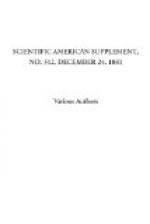The force of caloric is mobile, and is capable of moving from one portion of matter to another; yet under certain conditions a portion of caloric is occluded in the matter by the force of attraction. That portion of caloric which is occluded (known by the misnomer, latent heat) I shall call static caloric, and that portion which is in motion, dynamic caloric.
The force of attraction, as I have said, tends to draw the particles of matter together and hold them in a state of rest; but as this force is inherent, the degree of power thus exerted is in an inverse ratio to the distance of the particles from each other. The effective force so exerted is always balanced by an equivalent amount of the force of caloric, and that modicum of caloric so engaged in balancing the effective force of attraction is static, because occluded in that work.
In solid or fluid bodies, where the molecules are held in a local or near relation to each other, the amount of static caloric will be in direct proportion to the effective force of attraction, but in gaseous bodies the static caloric is in an inverse ratio to the effective force of attraction; hence the amount of static caloric present in solid and fluid bodies will be greatest when the molecules are nearest each other, and greatest in gaseous bodies when the molecules are furthest apart.
Caloric, whether static or dynamic, is not phenomenal; therefore the phenomena of light, temperature, incandescence, luminosity, heat, cold, and motion, as well as all other phenomena, are due to the movement of matter caused by the physical forces. Thus we find that temperature is a phenomenal measure of molecular velocity, as we consider weight to be the measure of matter.
An increase of temperature denotes an increased molecular velocity, and this in solid and liquid bodies unlocks a portion of the static caloric and converts it into dynamic caloric, while an increased temperature of gases occludes additional caloric, thus converting dynamic into static caloric; and a reduction of molecular activity reverses this action. From this we see that a change of temperature either converts static to dynamic or dynamic to static caloric.
Thus we find that the amount of static caloric which a body possesses is in direct relation to its temperature, but, as I have already explained, temperature is a phenomenal indication of molecular velocity, and as increased velocity separates the molecules to a greater distance, which reduces the effective force of attraction and unlocks a portion of caloric, it will be seen that the separation of the molecules from any other cause will have the same effect. I desire now to explain a second method by which the molecules are separated and static caloric is changed to dynamic caloric.




